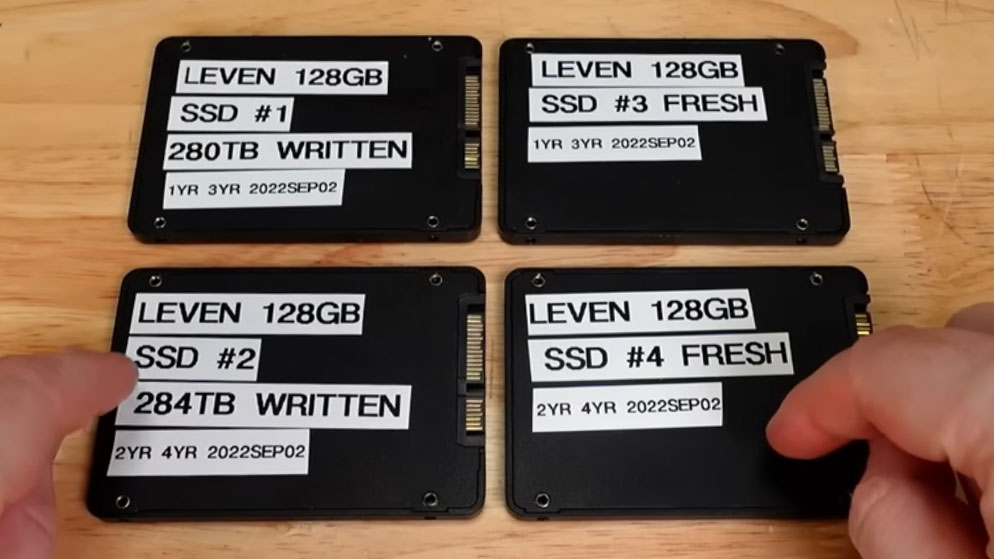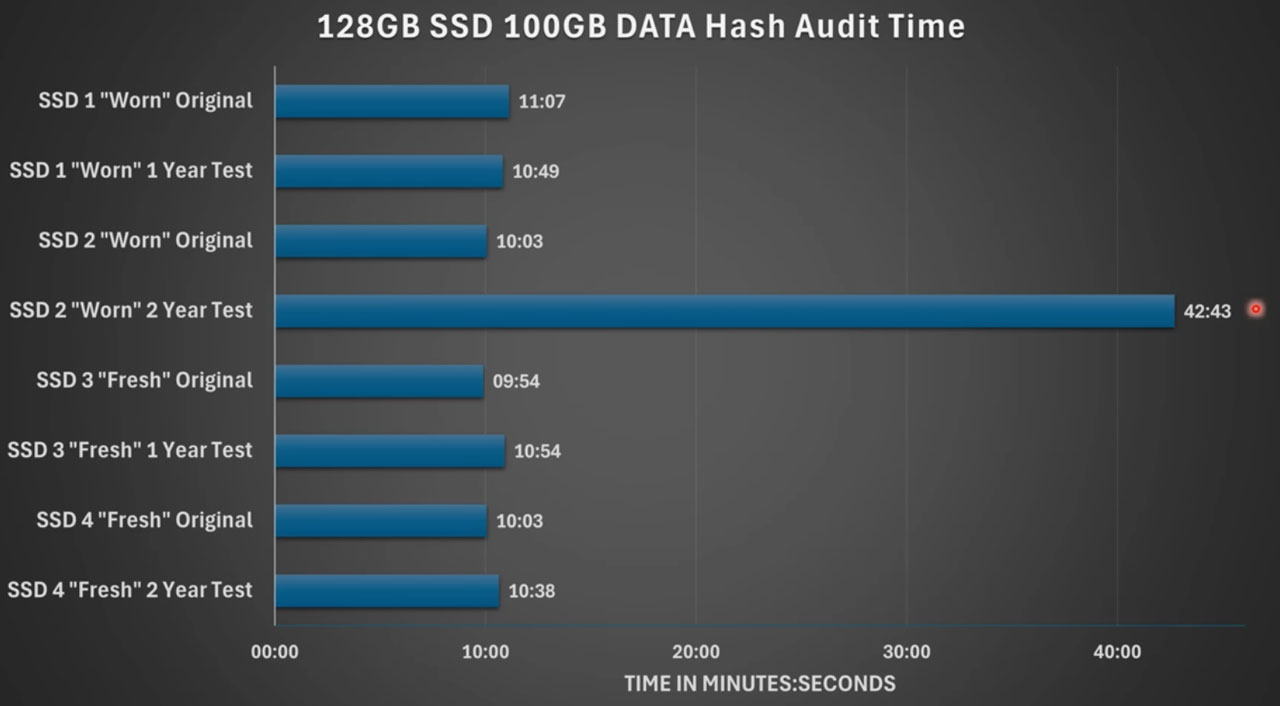Unpowered SSD endurance investigation finds severe data loss and performance issues
YouTuber SSD tests reveals problems all round on two-year-old TLC drives.

You may not know it, but SSDs will lose data after a period of time if they are simply left unplugged, which can be a serious threat to your data if you store backups or precious files on unplugged SSDs. A year-two update on the how long can SSDs store data unpowered video series is another reminder about the importance of regularly refreshing your backups with a bit of juice. The tests consist of storing data on an SSD and then leaving it unplugged for years to see the impact on the stored data.
As a reminder, an SSD's endurance rating is calculated based on how long it can store data if left unplugged after a certain amount of data has been written, hence the importance of this testing.
TechTuber HTWingNut is back with a report on his modest experiment involving a quartet of SATA SSDs. The key finding was that the two-year-old, well-worn drive exhibited noticeable performance degradation and was affected by a handful of corrupt files. These are signs that this particular SSD was on its way to silicon heaven. HTWingNut's video is an update on an episode from a year earlier, and further updates are promised.
The four tested 'Leven JS-600' branded SSDs are basically bog-standard no-name units. HTWingNut says they are all TLC SSDs of 128GB capacity and rated to withstand 60 TB of written data. Every drive has 100GB of files containing random data, with hash values for all the content provided for later verification.
The two 'Fresh' samples have barely been used; perhaps only the 100GB data set was put on there and verified, and that's it. Meanwhile, the 'Worn' drives have been subjected to 280 terabytes of written data churn, much more than their rated 60 Terabytes Written (TBW) endurance rating..
If you watch the previous year-one video, you will have seen there were no issues with either 'Worn' or 'Fresh' drives. However, time has now taken its toll. Let's take a look at the year-two samples in turn.
'Fresh' SSD tests
The data on this SSD, which hadn't been used or powered up for two years, was 100% good on initial inspection. All the data hashes verified, but it was noted that the verification time took a smidgen longer than two years previously. HD Sentinel tests also showed good, consistent performance for a SATA SSD.
Get Tom's Hardware's best news and in-depth reviews, straight to your inbox.
Digging deeper, all isn't well, though. Firing up Crystal Disk Info, HTWingNut noted that this SSD had a Hardware ECC Recovered value of over 400. In other words, the disk's error correction had to step in to fix hundreds of data-based parity bits.
Seeing these errors means "the SSD is on its way out," according to HTWingNut. Indeed, if there is anything iffy about your data storage integrity, it is at least a warning. However, the errors could also have something to do with the drive being left unpowered for two years.

'Worn' SSD tests
As the worn SSD's data was being verified, there were already signs of performance degradation. The hashing audit eventually revealed that four files were corrupt (hash not matching). Looking at the elapsed time, it was observed that this operation astonishingly took over 4x longer, up from 10 minutes and 3 seconds to 42 minutes and 43 seconds.
Further investigations in HD Sentinel showed that three out of 10,000 sectors were bad and performance was 'spiky.' Returning to Crystal Disk Info, things look even worse. HTWingNut notes that the uncorrectable sectors count went from 0 to 12 on this drive, and the hardware ECC recovered value went from 11,745 before to 201,273 after tests on the day.
Some takeaways
In summary, the year-one fresh and well-worn drives had no issues. However, the year-two heavily worn SSD had file corruption and performance was poor. The so-called fresh drive was still good, but ECC figures still raised concern. Come back in late 2025 for the next update from HTWingNut.
We also want to say this is a very small test sample, highlighted out of our interest in the topic rather than for its hard empirical data. I have also experienced SSD data loss after leaving a Mini PC unpowered for just six months or so at my pied-à-terre in Taiwan. On return, Windows refused to boot or be repaired, but a reformat and reinstall seemed to return everything to normal.
Follow Tom's Hardware on Google News to get our up-to-date news, analysis and reviews in your Google feeds. Make sure to click the Follow button.

Mark Tyson is a news editor at Tom's Hardware. He enjoys covering the full breadth of PC tech; from business and semiconductor design to products approaching the edge of reason.
-
Moores_Ghost I have a 10 year old OCZ SATA III SSD I've have had off for 3 years. When I saw this, I took it and the M.2 NVMe that housed the OS that I had paired with said drive and powered them on. To my surprise, there was nothing gone. No corruption. No issues. Granted mine were improperly stored in the laptop I put them in and placed on a shelf but there you have it.Reply
I have 2 more like it. Not powered on in 3 or more years. I'll let those sit longer. -
hwertz I had a *powered* hard drive a while back that started having issues, but only on older files. Turns out the file system (and disk) were well over 10 years old and the drive did nothing to 'freshen up' data, so newer written data was fine and really old files had a few errors. (I ran some utility or other to read and rewrite the entire drive, then it was fine again.)Reply
I went through some IDE drives where i did a read test, then zero'ed them, and the REST of my drives -- including one where last use was close to 20 years ago -- were fine. (One had stiction or stuck bearing or something, it didn't spin up until i gave it a thwack. But THEN ran fine. This was like a 80MB -- yes MB not GB -- drive though so probanly close to 35 years old. And who knows how long it was sitting.)
Cold storage is trickty! I'd 'trust' HDD over SSD to not spontaneously lose the data, but the bearings could stick, stiction, if it's a modern high capacity drive the helium could leak out (my 16TB drive I have now... not for cold storage, for live storage... doesn't have a SMART measure for estimated helium remaining so I'm REALLY hoping it gives warning signs when it's time is due ratrher than just dropping dead... if indeed that's what happens.). The SSD is more prone to loss but the HDD has all those moving parts to have something go wrong with.
It sounds like if that's the goal, tape is still a good way to go. And making sure to use.a standard format so you can still find a compatible drive in many years if your old one fails (or, they've changed connectors and your old drive will no longer hook up (past examples, SCSI tape drives, or those ones that'd hook to floppy controller. Good luck plugging that in now.) -
EdTittel Gosh! I'd be a LOT more inclined to get my reliability and lifetime data from a source like BackBlaze.com, which rates both hard drives and SSD used in a data center environment. Right now they report over a total of 300K+ drives and ~27M drive days. You need big numbers and lots of data to properly understand reliability and failure rates. That said, the info here is interesting because drives kept unpowered in NOT something that most sources report.Reply
--Ed-- -
punkncat I've been storing things on unpowered SSD for years and have yet to have any issues that wouldn't arise even being powered. Mostly bit rot on things like audio files. I also keep a large HDD with storage, check it every year or so and have had zero issues with it. I was rather surprised to learn that optical media is actually a fairly poor way to keep archived info. Years ago we were told they "lasted forever" and then you find out about oxidation...Reply -
JayGau Reply
Same here. I have several SSDs with old backups and files on them and never have had any corruption or other problems after several years without powering them on. I recently took a look at several of them that hadn't been powered on for at least 3 years and everything seemed to be just fine.punkncat said:I've been storing things on unpowered SSD for years and have yet to have any issues that wouldn't arise even being powered. Mostly bit rot on things like audio files. I also keep a large HDD with storage, check it every year or so and have had zero issues with it. I was rather surprised to learn that optical media is actually a fairly poor way to keep archived info. Years ago we were told they "lasted forever" and then you find out about oxidation...
And in my opinion, this performance degradation thing is quite misleading. I mean, of course if the drive is filled with corrupted files and errors the performance will take a hit, but just format it and you gonna have it back like new. You won't make me believe that SSDs that have been on a store shelf for more than 2 years should all be thrown away because of some "performance degradation" for not being powered on. -
USAFRet Note that the fails were after drives had been written FAR beyond the factory TBW rating.Reply
Meanwhile, the 'Worn' drives have been subjected to 280 terabytes of written data churn, much more than their rated 60 Terabytes Written (TBW) endurance rating.
And then left sitting for 2 years. -
punkncat ReplyUSAFRet said:Note that the fails were after drives had been written FAR beyond the factory TBW rating.
And then left sitting for 2 years.
I see. Apparently, I missed the part that mentioned they used the drives beyond the expected number of R/W and then created a situation to make an article about. Thanks for the clarity on this shoddy excuse for a subject. -
USAFRet Reply
Written far beyond... has been the case in every article or report that says "Unpowered SSDs lose data after <whatever>! "punkncat said:I see. Apparently, I missed the part that mentioned they used the drives beyond the expected number of R/W and then created a situation to make an article about. Thanks for the clarity on this shoddy excuse for a subject.
Used, abused, then left on a shelf for years. -
hurnii The article is actually milder / less scary than it should be.Reply
My wife had a laptop (used IBM/Lenovo Thinkpad) which originally had an HDD, which I upgraded to an SSD (Plextor PX-512S2C), back in 2017. Windows 7 OS install, some applications, and then light usage (roughly 2 TB written, total, meaning average of 4x writes to each block, not allowing for write amplification). And, we're talking MLC, not TLC.
Laptop was "retired" 3 years later (replaced by a brand new Lenovo Thinkpad), in early 2020. Was powered down.
In late 2023, roughly 3.5 years later, she accidentally deleted a file on the new Laptop, and powered up her retired laptop, expecting to be able to copy the file over.
Nope. Laptop refused to boot. I got involved ("Honey..."). Removed SSD from laptop, connected to a desktop, and started running chkdsk /r.
Two and a half days later, chkdsk finally finished: several files were corrupt, but, after returning the SSD to the laptop, it would boot, and the desired file was intact.
I ended up getting an industrial/server 512G SSD replacement, with rated "5 years powered down," copied everything which survived over to it (and made a backup), put it in her laptop, made it bootable, and plan on powering up her laptop at least every 2 years, and re-running chkdsk /r, just in case something similar happens again. After reading this, I powered it up and ran chkdsk: it ran quickly, with no problems.
(She's not good with restoring from backup, and doesn't see why she should not be able to just power up the old laptop.)
She does have a point: Compare this with the first Laptop I bought her: a Gateway Solo from 1999. It has an HDD, was powered down for at least 12 years, and booted / ran chkdsk with no problem (we tried it when we discovered the problem with her Thinkpad's SSD).
So, yeah, light usage, MLC, good brand, and, uncorrectable "bit rot" after only 3.5 years powered down. I did not expect that.
Would definitely like to see more articles about retention performance of powered down SSDs. While ECC has gotten better (more correctable) over the years, the proliferation of TLC and especially QLC (just try to find an MLC drive, these days) must have had a negative impact.
